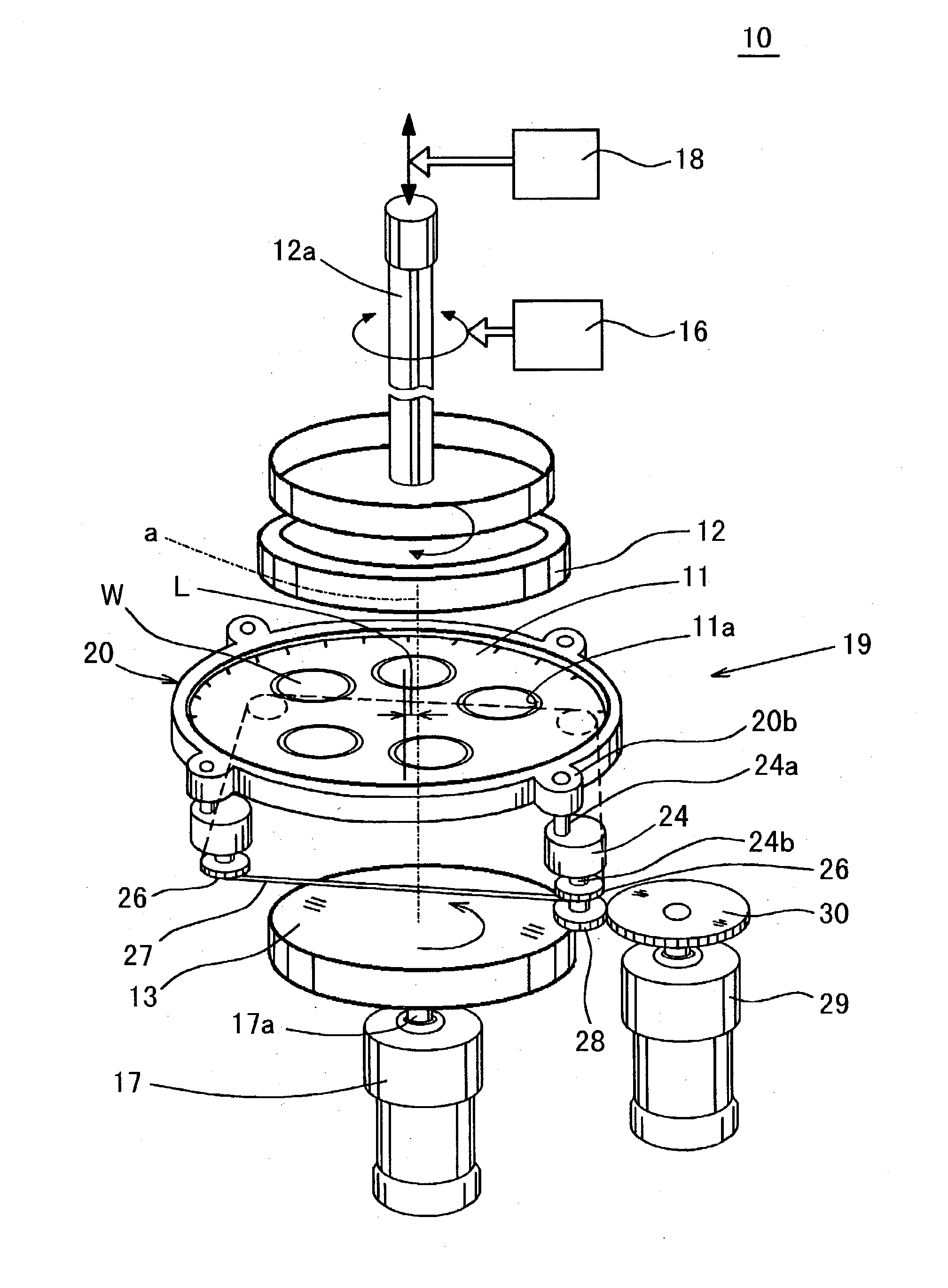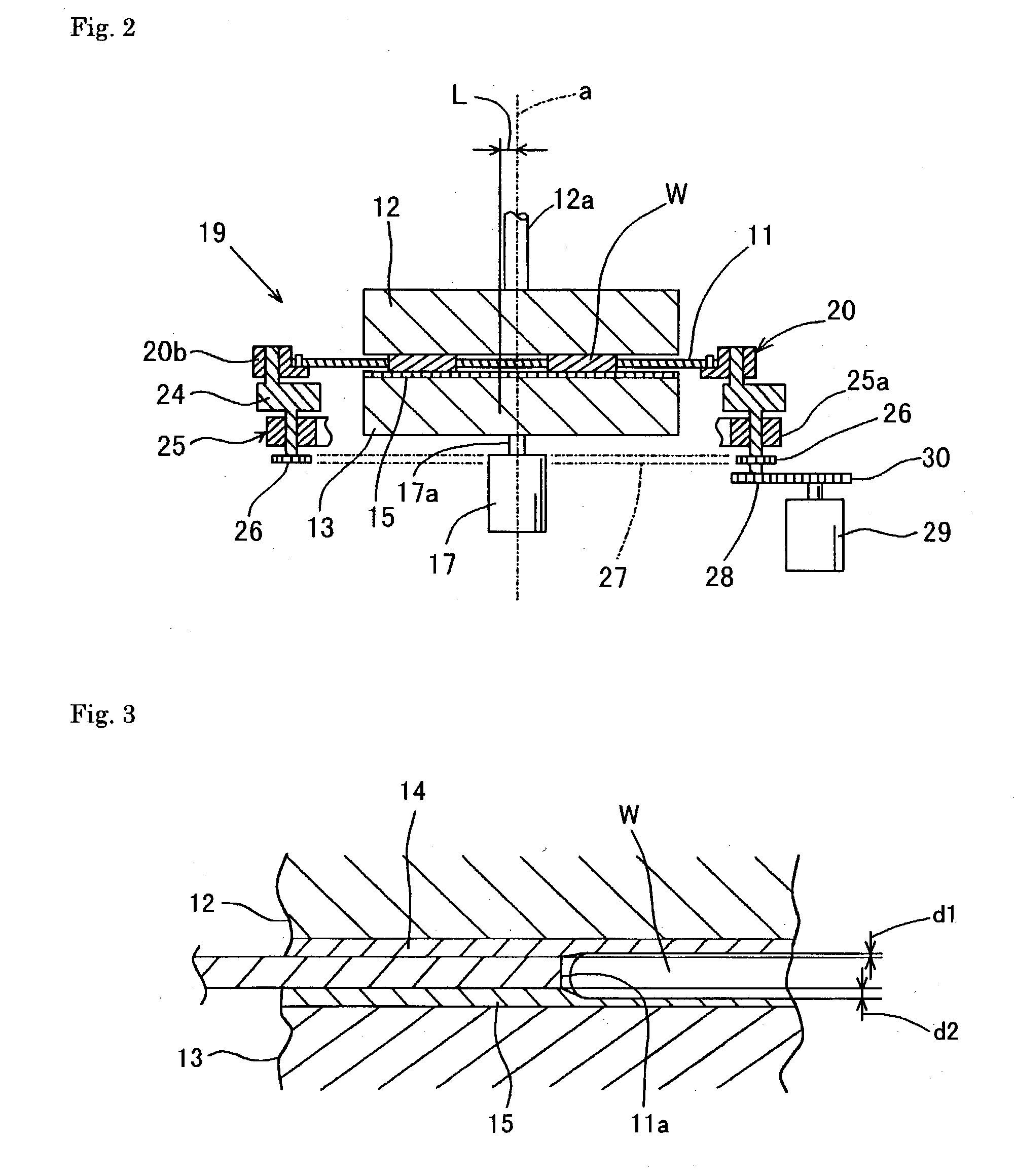Method of manufacturing semiconductor wafer
a manufacturing method and technology of semiconductor wafers, applied in the direction of manufacturing tools, grinding machines, lapping machines, etc., can solve the problems of increased quantity of wafer surface to be polished during subsequent double-sided polishing, increased manufacturing equipment, and longer polishing tim
- Summary
- Abstract
- Description
- Claims
- Application Information
AI Technical Summary
Benefits of technology
Problems solved by technology
Method used
Image
Examples
first embodiment
[0135] In FIG. 1 and FIG. 2, reference numeral 10 generally designates a double-sided polisher used in a method of manufacturing a semiconductor wafer according to the present invention. This double-sided polisher 10 comprises a carrier plate 11 made of epoxy-glass having a circular disc-like shape in plan view in which five of wafer holding holes 11a have been formed by every 72 degrees (in the circumferential direction) around an axis line of the plate so as to penetrate through the plate, and a pair of upper surface plate 12 and lower surface plate 13 functioning for clamping silicon wafers "W", each having a diameter of 300 mm and having inserted and thus held operatively in the wafer holding hole 11a so as to be free to rotate therein, from above and below sides with respect to the wafers W and also functioning for polishing the surfaces of the wafers W by moving themselves relatively with respect to the silicon wafers W. The carrier plate 11 is disposed between the upper surfa...
second embodiment
[0162] Referring now to FIG. 7, a method of manufacturing semiconductor wafer according to the present invention will now be described.
[0163] As shown in FIG. 7, this second embodiment is representative of an example that has employed, instead of the hard expanded urethane foam pad 14 extended over the upper surface plate 12 in the first embodiment, a hard plastic plate 40 which allows almost no slurry to attach to the surface thereof.
[0164] This configuration allows, during polishing process, exclusively the front surface of the silicon wafer W to sink into the soft non-woven fabric pad 15 at a sink rate of d2 and thus to be mirror-polished, while the back surface of the silicon wafer W, which is engaged with the hard plastic plate 40, may not be polished at all. By way of this, the silicon wafer may be finished with the waviness (nanotopography) created by the acid etching left in the back surface as it was.
[0165] Other description on configuration, operation and effect of this em...
third embodiment
[0166] A method of manufacturing a semiconductor wafer according to the present invention will now be described.
[0167] In the third embodiment, the polishing cloths extended over the upper surface plate 12 and the lower surface plate 13, as used in the first embodiment shown in FIG. 1, are specified as the same soft non-woven fabric pads 15, in which the upper surface plate 12 is driven by the upper rotary motor 16 to rotate at a lower speed (5 rpm), while the lower surface plate 13 is driven by the lower rotary motor 17 to rotate at a higher speed (25 rpm) to carry out a double-sided polishing. At that time, the slurry is supplied at a rate of 2.0 litter / min, and the quantity to be polished off from the front surface of the wafer is 10 .mu.m and that from the back surface of the wafer is equal to or less than 1 .mu.m.
[0168] With this arrangement, different polishing rates are created between the front and the back surfaces of the wafer, which in turn brings a difference in glossine...
PUM
 Login to View More
Login to View More Abstract
Description
Claims
Application Information
 Login to View More
Login to View More - R&D
- Intellectual Property
- Life Sciences
- Materials
- Tech Scout
- Unparalleled Data Quality
- Higher Quality Content
- 60% Fewer Hallucinations
Browse by: Latest US Patents, China's latest patents, Technical Efficacy Thesaurus, Application Domain, Technology Topic, Popular Technical Reports.
© 2025 PatSnap. All rights reserved.Legal|Privacy policy|Modern Slavery Act Transparency Statement|Sitemap|About US| Contact US: help@patsnap.com



